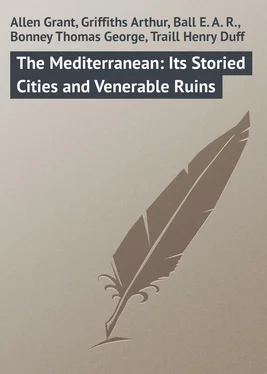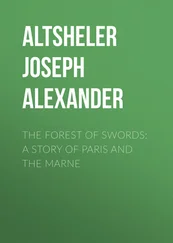E. Ball - The Mediterranean - Its Storied Cities and Venerable Ruins
Здесь есть возможность читать онлайн «E. Ball - The Mediterranean - Its Storied Cities and Venerable Ruins» — ознакомительный отрывок электронной книги совершенно бесплатно, а после прочтения отрывка купить полную версию. В некоторых случаях можно слушать аудио, скачать через торрент в формате fb2 и присутствует краткое содержание. Жанр: Путешествия и география, foreign_prose, foreign_language, на английском языке. Описание произведения, (предисловие) а так же отзывы посетителей доступны на портале библиотеки ЛибКат.
- Название:The Mediterranean: Its Storied Cities and Venerable Ruins
- Автор:
- Жанр:
- Год:неизвестен
- ISBN:нет данных
- Рейтинг книги:3 / 5. Голосов: 1
-
Избранное:Добавить в избранное
- Отзывы:
-
Ваша оценка:
- 60
- 1
- 2
- 3
- 4
- 5
The Mediterranean: Its Storied Cities and Venerable Ruins: краткое содержание, описание и аннотация
Предлагаем к чтению аннотацию, описание, краткое содержание или предисловие (зависит от того, что написал сам автор книги «The Mediterranean: Its Storied Cities and Venerable Ruins»). Если вы не нашли необходимую информацию о книге — напишите в комментариях, мы постараемся отыскать её.
The Mediterranean: Its Storied Cities and Venerable Ruins — читать онлайн ознакомительный отрывок
Ниже представлен текст книги, разбитый по страницам. Система сохранения места последней прочитанной страницы, позволяет с удобством читать онлайн бесплатно книгу «The Mediterranean: Its Storied Cities and Venerable Ruins», без необходимости каждый раз заново искать на чём Вы остановились. Поставьте закладку, и сможете в любой момент перейти на страницу, на которой закончили чтение.
Интервал:
Закладка:
Nor are even Oriental buildings of great architectural pretensions wanting to this newer French city. The conquerors, in reconstructing Algiers on the Parisian model, have at least forborne to Haussmannise in every instance the old mosques and palaces. The principal square, a broad place lined with palm-trees, is enlivened and made picturesque by the white round dome and striking minarets of the Mosquée de la Pêcherie. Hard by stands the Cathedral, a religious building of Mussulman origin, half Christianized externally by a tower at each end, but enclosing within doors its old Mohammedan mimbar and many curious remains of quaint Moorish decoration. The Archbishopric at its side is a Moorish palace of severe beauty and grandeur; the museum of Græco-Roman antiques is oddly installed in the exquisite home raised for himself by Mustapha Pasha. The Great Mosque, in the Rue Bab-el-Oued, remains to us unspoiled as the finest architectural monument of the early Mohammedan world. That glorious pile was built by the very first Arab conquerors of North Africa, the companions of the Prophet, and its exquisite horse-shoe arches of pure white marble are unsurpassed in the Moslem world for their quaintness, their oddity, and their originality.
The interior of this mosque is, to my mind, far more impressive than anything to be seen even in Cairo itself, so vast it is, so imposing, so grand, so gloomy. The entire body of the building is occupied throughout by successive arcades, supported in long rows by plain, square pillars. Decoration there is none; the mosque depends for effect entirely on its architectural features and its noble proportions. But the long perspective of these endless aisles, opening out to right and left perpetually as you proceed, strikes the imagination of the beholder with a solemn sense of vastness and mystery. As you pick your way, shoeless, among the loose mats on the floor, through those empty long corridors, between those buttress-like pillars, the soul shrinks within you, awe-struck. The very absence of images or shrines, the simplicity and severity, gives one the true Semitic religious thrill. No gauds or gewgaws here. You feel at once you are in the unseen presence of the Infinite and the Incomprehensible.
The very first time I went into the Great Mosque happened, by good luck, to be the day of a Mohammedan religious festival. Rows and rows of Arabs in white robes filled up the interspaces of the columns, and rose and fell with one accord at certain points of the service. From the dim depths by the niche that looks towards Mecca a voice of some unseen ministrant droned slowly forth loud Arabic prayers or long verses from the Koran. At some invisible signal, now and again, the vast throng of worshippers, all ranged in straight lines at even distances between the endless pillars, prostrated themselves automatically on their faces before Allah, and wailed aloud as if in conscious confession of their own utter unworthiness. The effect was extraordinary, electrical, contagious. No religious service I have ever seen elsewhere seemed to me to possess such a profundity of earnest humiliation, as of man before the actual presence of his Maker. It appeared to one like a chapter of Nehemiah come true again in our epoch. We few intrusive Westerns, standing awe-struck by the door, slunk away, all abashed, from this scene of deep abasement. We had no right to thrust ourselves upon the devotions of these intense Orientals. We felt ourselves out of place. We had put off our shoes, for the place we stood upon was holy ground. But we slunk back to the porch, and put them on again in silence. Outside, we emerged upon the nineteenth century and the world. Yet even so, we had walked some way down the Place de la Régence, among the chattering negro pedlers, before one of us dared to exchange a single word with the other.
If the new town of Algiers is interesting, however, the old town is unique, indescribable, incomprehensible. No map could reproduce it; no clue could unravel it. It climbs and clambers by tortuous lanes and steep staircases up the sheer side of a high hill to the old fortress of the Deys that crowns the summit. Not one gleam of sunshine ever penetrates down those narrow slits between the houses, where two people can just pass abreast, brushing their elbows against the walls, and treading with their feet in the poached filth of the gutter. The dirt that chokes the sides is to the dirt of Italy as the dirt of Italy is to the dirt of Whitechapel. And yet so quaint, so picturesque, so interesting is it all, that even delicate ladies, with the fear of typhoid fever for ever before their eyes, cannot refuse themselves the tremulous joy of visiting it and exploring it over and over again; nay, more, of standing to bargain for old brass-work or Algerian embroidery with keen Arab shopkeepers in its sunless labyrinths. Except the Mooskee at Cairo, indeed, I know no place yet left where you can see Oriental life in perfection as well as the old town of Algiers. For are there not tramways nowadays even in the streets of Damascus? Has not a railway station penetrated the charmed heart of Stamboul? The Frank has done his worst for the lower town of his own building, but the upper town still remains as picturesque, as mysterious, and as insanitary as ever. No Pasteur could clean out those Augean stables.
In those malodorous little alleys, where every prospect pleases and every scent is vile, nobody really walks; veiled figures glide softly as if to inaudible music; ladies, muffled up to their eyes, use those solitary features with great effect upon the casual passer-by; old Moors, in stately robes, emerge with stealthy tread from half-unseen doorways; boys clad in a single shirt sit and play pitch-and-toss for pence on dark steps. Everything reeks impartially of dirt and of mystery. All is gloom and shade. You could believe anything on earth of that darkling old town. There all Oriental fancies might easily come true, all fables might revive, all dead history might repeat itself.
These two incongruous worlds, the ancient and the modern town, form the two great divisions of Algiers as the latter-day tourist from our cold North knows it. The one is antique, lazy, sleepy, unprogressive; the other is bustling, new-world, busy, noisy, commercial. But there is yet a third Algiers that lies well without the wall, the Algiers of the stranger and of the winter resident. Hither Mr. Cook conducts his eager neophytes; hither the Swiss innkeeper summons his cosmopolitan guests. It reaches its culminating point about three miles from the town, on the heights of Mustapha Supérieur, where charming villas spread thick over the sunlit hills, and where the Western visitor can enjoy the North African air without any unpleasant addition of fine old crusted Moorish perfumes.
The road to Mustapha Supérieur lies through the Bab-Azzoun gate, and passes first along a wide street thronged with Arabs and Kabyles from the country and the mountains. This is the great market road of Algiers, the main artery of supplies, a broad thoroughfare lined with fondouks or caravanserais, where the weary camel from the desert deposits his bales of dates, and where black faces of Saharan negroes smile out upon the curious stranger from dense draping folds of some dirty burnouse. The cafés are filled with every variety of Moslem, Jew, Turk, and infidel. Nowhere else will you see to better advantage the wonderful variety of races and costumes that distinguishes Algiers above most other cosmopolitan Mediterranean cities. The dark M’zabite from the oases, arrayed like Joseph in a coat of many colors, stands chatting at his own door with the pale-faced melancholy Berber of the Aurès mountains. The fat and dusky Moor, over-fed on kous-kous, jostles cheek by jowl with the fair Jewess in her Paisley shawl and quaint native head-gear. Mahonnais Spaniards from the Balearic Isles, girt round their waists with red scarves, talk gaily to French missionary priests in violet bands and black cassocks. Old Arabs on white donkeys amble with grave dignity down the center of the broad street, where chasseurs in uniform and spahis in crimson cloaks keep them company on fiery steeds from the Government stud at Blidah. All is noise and bustle, hurry, scurry, and worry, the ant-hill life of an English bazaar grotesquely superimposed on the movement and stir of a great European city.
Читать дальшеИнтервал:
Закладка:
Похожие книги на «The Mediterranean: Its Storied Cities and Venerable Ruins»
Представляем Вашему вниманию похожие книги на «The Mediterranean: Its Storied Cities and Venerable Ruins» списком для выбора. Мы отобрали схожую по названию и смыслу литературу в надежде предоставить читателям больше вариантов отыскать новые, интересные, ещё непрочитанные произведения.
Обсуждение, отзывы о книге «The Mediterranean: Its Storied Cities and Venerable Ruins» и просто собственные мнения читателей. Оставьте ваши комментарии, напишите, что Вы думаете о произведении, его смысле или главных героях. Укажите что конкретно понравилось, а что нет, и почему Вы так считаете.












